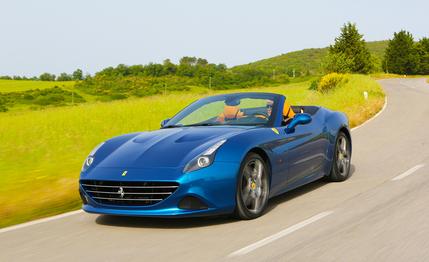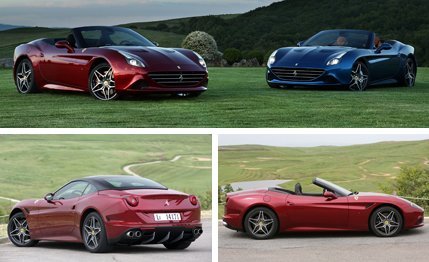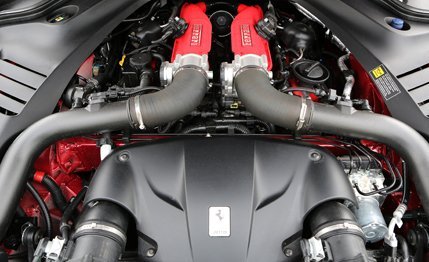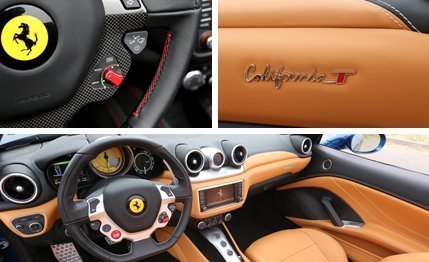 First Drive Review
First Drive Review
Five years ago, if you’d asked Ferrari engineers why they didn’t use turbochargers, you probably would’ve gotten colorful responses involving a lot of suggestive hand gestures. With very few exceptions (F40), forced induction used to be blasphemous in Maranello—not enough aural emotion.
And now here we have the new California T, short for turbo. What are we to make of this? Is Ferrari simply holding out on its entry-level American customers, leaving the good, naturally aspirated stuff slightly out of reach? Or has turbocharging somehow redeemed itself in better Modenese society?
Before we answer the foregoing, know that the updated Cali brings more than just a pair of turbos. All the sheetmetal is new with the exception of the folding roof. To flatten the car’s tall and ungainly rear end, Ferrari pushed the taillights outboard, trimmed the trailing edge of the decklid by 0.5 inch, and reorganized the exhaust pipes from oddly stacked pairs to more-conventional horizontal duals. The visual trickery works from the outside, making the rear seem lower and wider. But there is no disguising the high trunk from the driver’s seat. In the rearview mirror, it still looks like the car is wearing a large backpack.

The new turbocharged engine is based on the Maserati V-8, though block architecture is about all this 3.9-liter shares with the engine of its corporate brother. The Ferrari version gets a flat-plane crankshaft, special heads, and complex headers with three-piece cast-and-welded construction and equal-length runners. Those headers feed equally spaced exhaust pulses to twin-scroll turbos, which charge the intake manifold with a maximum of 18.9 psi of boost.
In a frank moment, Ferrari admits that the 3.9’s throttle response is slower than the outgoing 4.3-liter engine’s, though we found negligible turbo lag. From Ferrari’s perspective, direct injection is the key to making a turbo engine suitable for its clients. It may not quite have the response of a naturally aspirated Ferrari mill, but it’s still got the goods: A 60-mph dash shouldn’t take more than 3.5 seconds with the quarter-mile coming up in 11.6 ticks. Both are major improvements over the old California.
Ferrari claims the engine downsizing will pull the Cali out of gas-guzzler-tax range, and we estimate EPA mileage of 17 mpg city, 24 highway. But the company also acknowledges the obvious: A heavy throttle will diminish efficiency. We’d love to hear Ford admit that of its EcoBoost-branded engines.

Still, the combination of improved fuel economy from a smaller V-8 and increased performance bestowed by turbochargers was too much for Ferrari to ignore.
Mash the accelerator pedal and there is just a faint whistle indicating that this engine is force-fed. Lumber along in a higher gear and the turbos muffle the exhaust note. At high rpm, though, the engine emits the unmistakable wail of a flat-plane Ferrari V-8.
Engine management manipulates the maximum available torque, depending on the selected gear. About 450 pound-feet is on call in first through third gears, ramping up slightly for each gear thereafter to a maximum of 557 at 2750 rpm in seventh. This makes the 552-hp engine feel more like a peaky, naturally aspirated V-8.

Like Barry White’s, “smooth” is this touring car’s mantra, and the T does touring as well as any other 2+2 out there. With the newest magnetorheological dampers and 12-percent-stiffer springs, the T rides exceptionally well. What appear to be spine-smacking potholes come and go with little more than some flutter and noise.
Test driver Fabrizio Toschi says the car will turn a one-minute-28-second lap at Ferrari’s Fiorano circuit, but that “it doesn’t matter in this kind of car.” Lightly weighted steering barely loads up in corners. Nonetheless, the standard carbon-ceramic brakes are built for track duty, with plenty of feedback and pedal feel.
Will Ferrari turbocharge all its future models for incremental gains in efficiency? Probably not. But we’ll be sure to check back in five years.